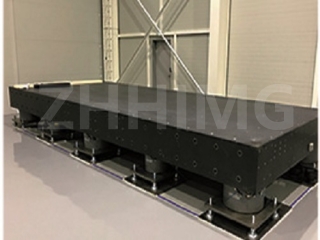In the construction of precision static pressure air floating platform, the choice of base plays a decisive role in the overall performance of the platform. Granite precision base and cast iron base have their own characteristics, and there are obvious differences in key dimensions such as stability, accuracy maintenance, durability and cost.
First, stability: natural dense and metal structure
After millions of years of geological changes, granite is closely combined by quartz, feldspar and other minerals to form a very dense and uniform structure. In the face of external interference, such as the strong vibration generated by the operation of large equipment in the factory workshop, the granite base can effectively block and attenuate by relying on its complex crystal structure, which can reduce the vibration amplitude of the precision static pressure air floating platform by more than 80%, providing a stable operation cornerstone for the platform to ensure smooth movement during high-precision processing or detection. For example, in the photolithography process of electronic chip manufacturing, the precise characterization of chip patterns is guaranteed.
The cast iron base is cast from iron-carbon alloy, and the internal graphite is distributed in sheets or spheres. Although it has a certain vibration damping ability, its structural uniformity is not good compared with granite. When dealing with high intensity and continuous vibration, it is difficult for the cast iron base to reduce the vibration interference to the same low level as the granite base, which may lead to small deviations in the movement of the precision static pressure air floating platform, affecting the precision performance of the platform in ultra-precision operations.
Second, accuracy retention: the natural advantages of low expansion and the challenge of metal thermal change
Granite is known for its very low coefficient of thermal expansion, usually at 5-7 ×10⁻⁶/℃. In the temperature fluctuation environment, the size of the granite precision base changes very little. In the field of astronomy, the precision hydrostatic air float platform for the fine tuning of the telescope lens is paired with the granite base, even if the temperature difference between day and night is significant, it can ensure that the positioning accuracy of the lens is maintained at the submicron level, helping astronomers to capture the subtle dynamics of distant celestial bodies.
The coefficient of thermal expansion of cast iron is relatively high, generally 10-20 ×10⁻⁶/℃. When the temperature changes, the size of the cast iron base changes obviously, which is easy to cause thermal deformation of the precision static pressure air floating platform, resulting in the decline of the movement accuracy of the platform. In the grinding process of temperature-sensitive optical lenses, the deformation of cast iron base under the influence of temperature may cause the deviation of the grinding precision of the lens beyond the allowable range and affect the quality of the lens.
Third, durability: high hardness of natural stone and metal fatigue
Granite hardness is high, Mohs hardness can reach 6-7, good wear resistance. In the materials science laboratory, the frequently used precision static pressure air float platform, its granite base can effectively resist long-term friction loss, compared with ordinary base, can extend the maintenance cycle of the platform by more than 50%, reduce equipment maintenance costs, and ensure the continuity of scientific research work. However, the granite material is relatively brittle, and there is a risk of rupture when it is accidentally impacted.
The cast iron base has a certain toughness and is not easy to break when bearing a certain impact force. However, in the process of high frequency reciprocating movement of precision static pressure air floating platform for a long time, the cast iron is prone to fatigue damage, resulting in changes in the internal structure, affecting the movement accuracy and stability of the platform. At the same time, cast iron is prone to rust and corrosion in humid environments, reducing its durability, in contrast, granite base in corrosion resistance is better.
Fourth, manufacturing cost and processing difficulty: natural stone mining and processing challenges and metal casting process threshold
The mining and transportation of granite raw materials are complex, and the processing requires very high equipment and technology. Because of its high hardness, brittleness, cutting, grinding, polishing and other processes are prone to collapse, cracks, high scrap rate, resulting in high manufacturing costs.
The cast iron base is manufactured with mature casting process, wide source of raw materials and relatively low cost. Through the mold can achieve mass production, high production efficiency. However, in order to achieve the same high precision and stability as the granite base, the casting process and post-processing requirements are extremely strict, requiring precision machining and aging treatment, etc., and the cost will also rise significantly.
In summary, granite precision base has significant advantages in the application scenarios of precision static pressure air float platform which require high precision, stability and wear resistance; The cast iron base has certain advantages in cost and toughness, and is suitable for occasions where the accuracy requirements are relatively low, the pursuit of cost effectiveness and the vibration and temperature environment are relatively stable.
Post time: Apr-09-2025

